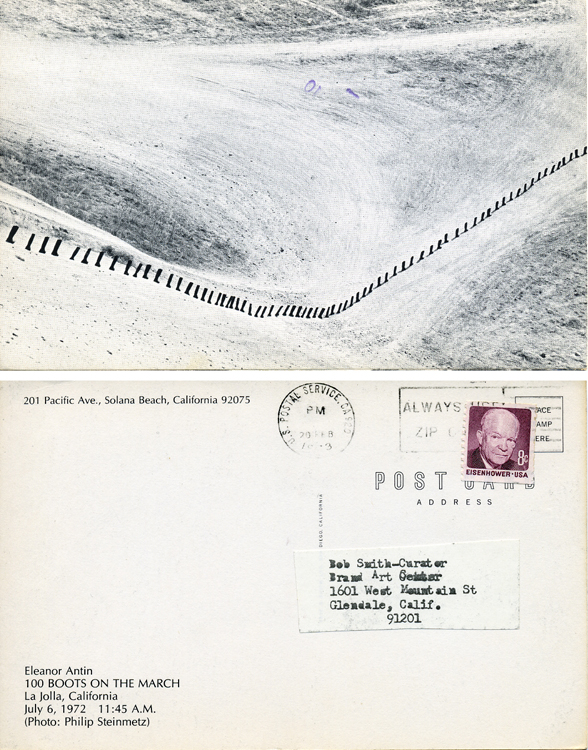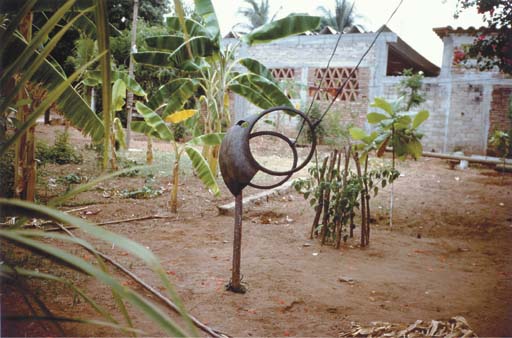Study for a Recycling Device
2005
11.8Hx 31.5W x 7D inches
Pedro Reyes
In Reyes’s words, “We should be able to extract the technological nutrients before we excrete our waste. There is a missing organ in our social metabolism which would work as a stomach or intestines. The Recyclone is a device made of plastic containers that fit into each other. (The plastic boxes are the equivalent to the ‘vellum,’ which are the tiny hairs that stick out from the intestinal wall to absorb nutrients). The permutation of this plastic bins could be customized to satisfy anyone’s recycling needs.” This work offers the possibility of a more visually appealing and adaptable recycling mechanism, assisting in the conscientious extraction of reusable material from industrial products.
Pedro Reyes’s works traverse the worlds of art, film, architecture, design, social criticism, and pedagogy. Educated as an architect, Reyes draws on this training to engage with utopian aspirations and the ongoing legacy of Modernism, often focusing on issues of scale and space while questioning pressing social issues through the incitement of individual or collective interaction. Although only a few of his works are directly located within the practice of building, almost all involve some kind of construction, whether they are objects, models, interiors, or social spaces. Reyes also makes use of strategies developed for communication or education, as well as everyday humor, to engage his audiences. Many of his works either allow large-scale public engagement or suggest a possible use: weapons turned to shovels, multilevel parks in old modernist buildings, and small spherical rooms. Like many avant-garde thinkers of the past, Reyes constructs new forms of architecture necessary for new ways of life.
Colors:
Other related works, blended automatically

© » KADIST
Pedro Reyes
2012Pedro Reyes’s Los Mutantes ( Mutants , 2012) is composed of 170 plates that combine characters from ancient and modern mythologies...

© » KADIST
Yoshua Okón
2009Canned Laughter was Okón’s response to an invitation from Ciudad Juárez , Mexico, where artists were asked to create works based on their experience of the city...

© » KADIST
Abraham Cruzvillegas
2004Wright Imperial Hotel (2004) is a sort of bow and arrow made out of feathers, a São Paulo phone book, and other materials...

© » KADIST
Pablo Rasgado
2011Pablo Rasgado’s paintings and installations serve as a visual record of contemporary urban human behavior...

© » KADIST
Jompet Kuswidananto
2011Third Realm (2011) grew out of the artist’s long-term research of Indonesia’s colonial history and the processes of modernization and urbanization that have taken place there...

© » KADIST
Mario Garcia Torres
Mario Garcia Torres discovered the work of artist Oscar Neuestern in an article published in ARTnews in 1969...

© » KADIST
Julio Cesar Morales
2011Contrabando is a work that references the larger sociological phenomenon in which immigrant economic strategies come to infiltrate urban landscapes...

© » KADIST
Mario Garcia Torres
2005Mario Garcia Torres films a game of Charades among professional actors guessing the former North Korean dictator’s favorite Hollywood films...

© » KADIST
Julieta Aranda
2016The video Swimming in rivers of Glue is composed of various images of nature, exploring the themes of exploration of space and its colonization...

© » KADIST
Eleanor Antin
1973Comprised of fifty-one photographic postcards, Antin’s 100 Boots is an epic visual narrative in which 100 black rubber boots stand in for a fictional “hero” making a “trip” from California to New York City...

© » KADIST
Fabiola Torres-Alzaga
2013Fabiola Torres-Alzaga plays with magic, illusion, and sleight-of-hand, fabricating installations, drawings, and films that toy with our perceptions...









